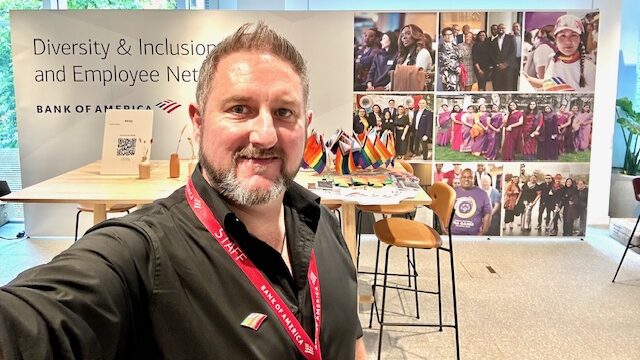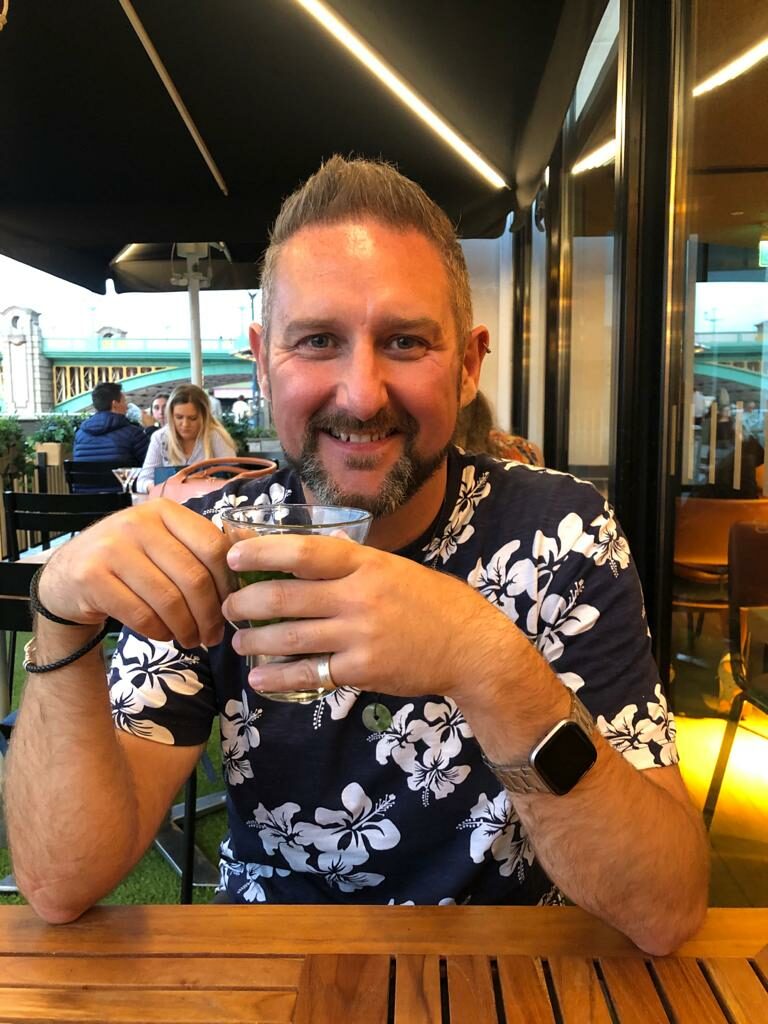Bank of America senior VP on LGBTQ+ ally program and how neurodiversity has shaped his perspective
In partnership with myGwork

Daniel Docherty describes his journey from a young boy who didn’t understand what made him different, to a professional co-designer of Bank of America’s LGBTQ+ employee resource group’s global ally program. He also offers a perspective on how his identity as a gay man intersects with being neurodivergent, and how both are ultimately strengths of his character.
Can you share your experience of growing up in a large Irish and Scottish Catholic family?
Growing up in such a large family with 11 uncles/aunties and 40+ cousins, means I have always felt part of a community. It’s a little crazy and people squabble, but ultimately someone is always there when you need them. Family gatherings are always huge, and we all have a great time. It’s very matriarchal and was always centered around my grandparents who made sure we were all okay. I love family life and can’t imagine not being a part of such a large one.
What was your journey like from recognising your identity to coming out to your family and friends?
Growing up I always knew I was different from others, but I did not understand why. Around the age of 12, my friends were looking at girls and I was just not interested – I had many girl friends, but never in a romantic way. I left school at 16 and went straight into work, working at the English National Opera as an usher, and found myself surrounded by people who were so open about being LGBTQ+ that it made me realise it was okay to like boys.

I was given a film called Beautiful Thing about a boy on a council estate with a mother who runs pubs – this was exactly my story. While watching the film my mum asked why I was crying, I said “I am like this boy in the film”. She sat down, watched the rest, and at the end just said, “I know you are, and tomorrow we can talk to your dad”. The next day we had an open conversation and they both just said they wanted me to be happy. I started telling my friends and people at work and everyone was so supportive. I have a saying that friends are the family (‘framily’) we choose, and I am so lucky to have the ones I do.
Looking back on your career, what moments stand out as particularly defining for you?
At 18, I joined Bank of America and vowed to never go back in the closet again. One year later, I and other gay people at the bank contacted the D&I Leader for our region asking if we could start an LGBTQ+ network chapter in Europe Middle East and Africa, which she supported. We already had an active LGBTQ+ Network in the US, with several chapters, reflecting the Bank’s commitment to progressing LGBTQ+ inclusion. I sat on the committee for a few years and when I was 22, I was asked to co-lead the network as well as the LGBTQ+ Interbank Network,which was a huge and exciting step. I was assigned a mentor who was the executive sponsor of the LGBTQ+ Network and who taught me you don’t need seniority to lead – having drive, passion and empathy gives you the power to inspire inclusion.

At 33, I co-designed a global ally program at the bank, now with over 40,000 members across 1000+ cities, 30+ countries and all US states. Working with the global allies, senior leaders, HR and D&I, we achieved a lot. For example, we were able to collaborate with our private healthcare provider to include lower surgery for anyone eligible to transition, working for us. It was one of the highlights of my career when I was able to call one of my colleagues, informing them they can now be seen privately, taking 7 years of their current wait.
At 41, I secured my senior vice president role, this was a significant achievement and a proud moment in my career journey to date.
You co-led and co-designed the Global LGBTQA+ Pride Ally program. What inspired you to take on this role, and what are its areas of success?
In 2012, I went to an LGBTQ+ conference in the US called The Out and Equal Summit, led by our long-standing Bank of America diversity partner Out & Equal, and met an amazing human called Aimee Broadhurst. We hit it off and went to all the Ally Program sessions because we knew we needed a program like that at Bank of America. I wanted to ensure our program was global in scope but local in nature, to allow the people on the ground to take part all over the world, in a way that suited them – even in places where being LGBTQA+ is unsafe.

We gathered the data we needed along with the support of a global leader and started to build our program, reaching out to key stakeholders to ensure we were covering all angles. Our main aim was to create an environment for people to bring their whole selves to work – this did not mean outing people, but having a safe visible environment when they were ready. We now have the data to show that we are having a positive impact.
How does Bank of America strive towards a more diverse and inclusive work environment?
Bank of America values everyone, from all walks of life. There’s a truly inclusive environment and culture here. It’s a place to get involved and be inspired, from volunteer opportunities to D&I events and initiatives, the company offers new ways to learn and grow, and make a difference for our clients and in our communities.
There are always opportunities to engage with a range of different people across the bank and I believe it’s the personal connections our employees make with each other that help build our strong and inclusive work culture. Through employee networks, ongoing activities and annual events friendships develop and are nurtured. We appreciate the value of these relationships and are proud to facilitate opportunities for employees to grow, learn and connect through shared interests.

We all want a job with purpose, to know that our time spent working contributes to greater good. At Bank of America, we’re proud of our investment in social and environmental causes, philanthropic partnerships, commitment to volunteering and daily focus on helping clients achieve their financial goals. Our employees really do have the power to make a difference.
Could you describe how being neurodiverse and dyslexic has influenced your perspective on leadership and inclusion in the workplace?
I live in a world that has not been designed for neurodiverse individuals. This means I must come up with ways to learn, develop and adapt, which makes me resilient and problem-solving focused. There is a growing understanding of what being neurodiverse broadly means and how individuals can be supported. We need to keep the dialogue around this going. Leaders have an important, positive role to play, to continue to understand what challenges neurodiverse individuals face, the mental strength required and then understand the support they can provide. They need to understand being neurodiverse is a superpower and to enhance this you need to create a culture of belonging in all its forms and foster diverse teams.
Bank of America has recently announced a new training programme for all employees, developed with our external partners, Neurodiversity in the Workplace. The program focuses on understanding neurodiversity and building inclusive workplace practices.
How do you see the future of diversity and inclusion evolving in the business landscape, particularly with emerging leaders?
It is hugely positive to see the topic included in leadership conversations, more and more people are aware of it and understand why it is important. We have come such a long way since I started in the working world. However, there’s always more that can be done. I see the future of D&Iat organisations evolving to increase focus on developing a culture of belonging, based on the intersectionality of its staff, clients, and the customers it serves.

Businesses need to continue to have open conversations, listen to employees and evolve their offering to meet the needs of today’s workforce. Consideration around creating programs, benefits, and objectives that ensure teams are not only diverse in nature but also in thought. All leaders need to understand this – this will help them survive the storms, support teams, retain talent, and get the most productivity and innovation from their employees.
Bank of America is a proud partner of myGwork, the LGBTQ+ business community. Find out more about LGBTQ+-friendly job opportunities at Bank of America.
